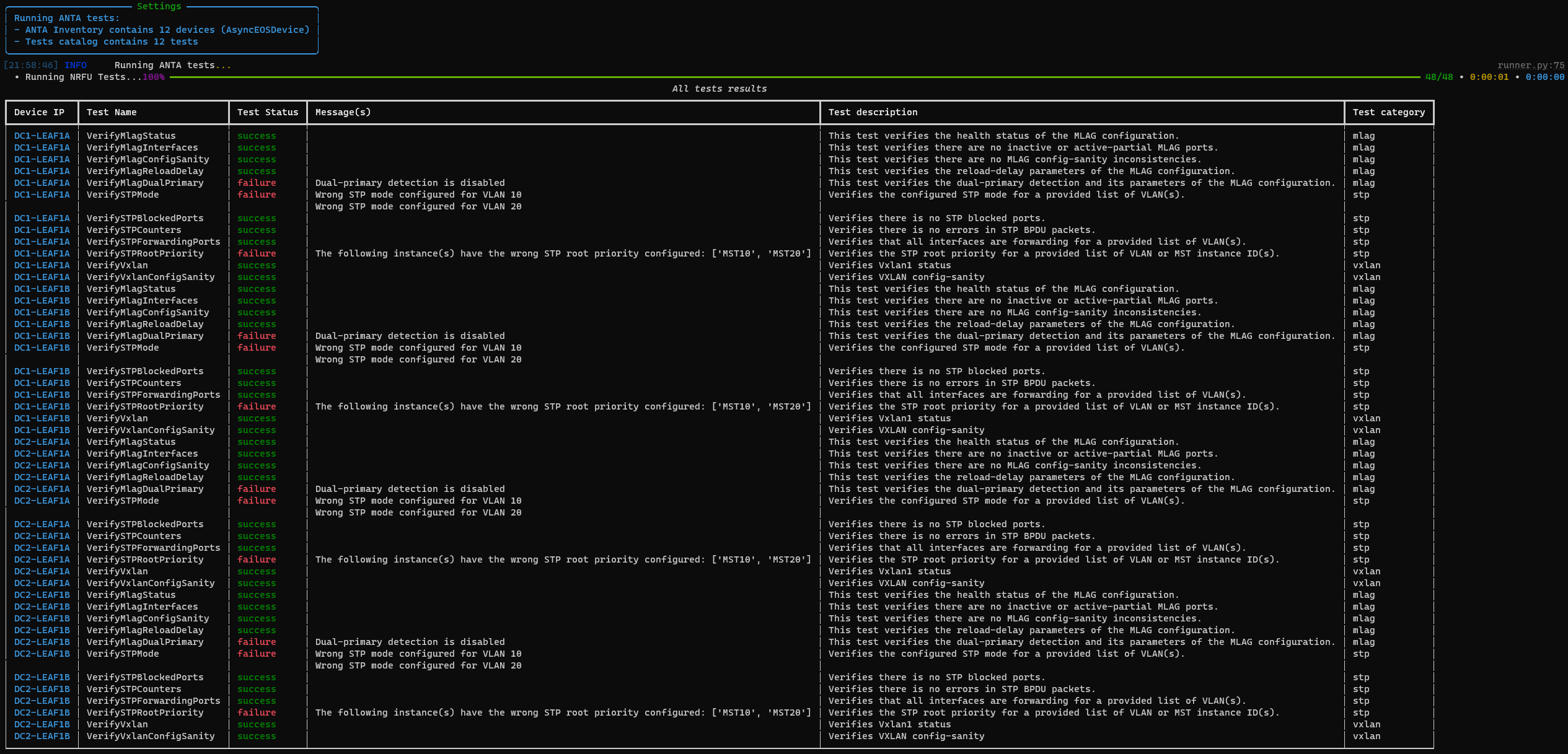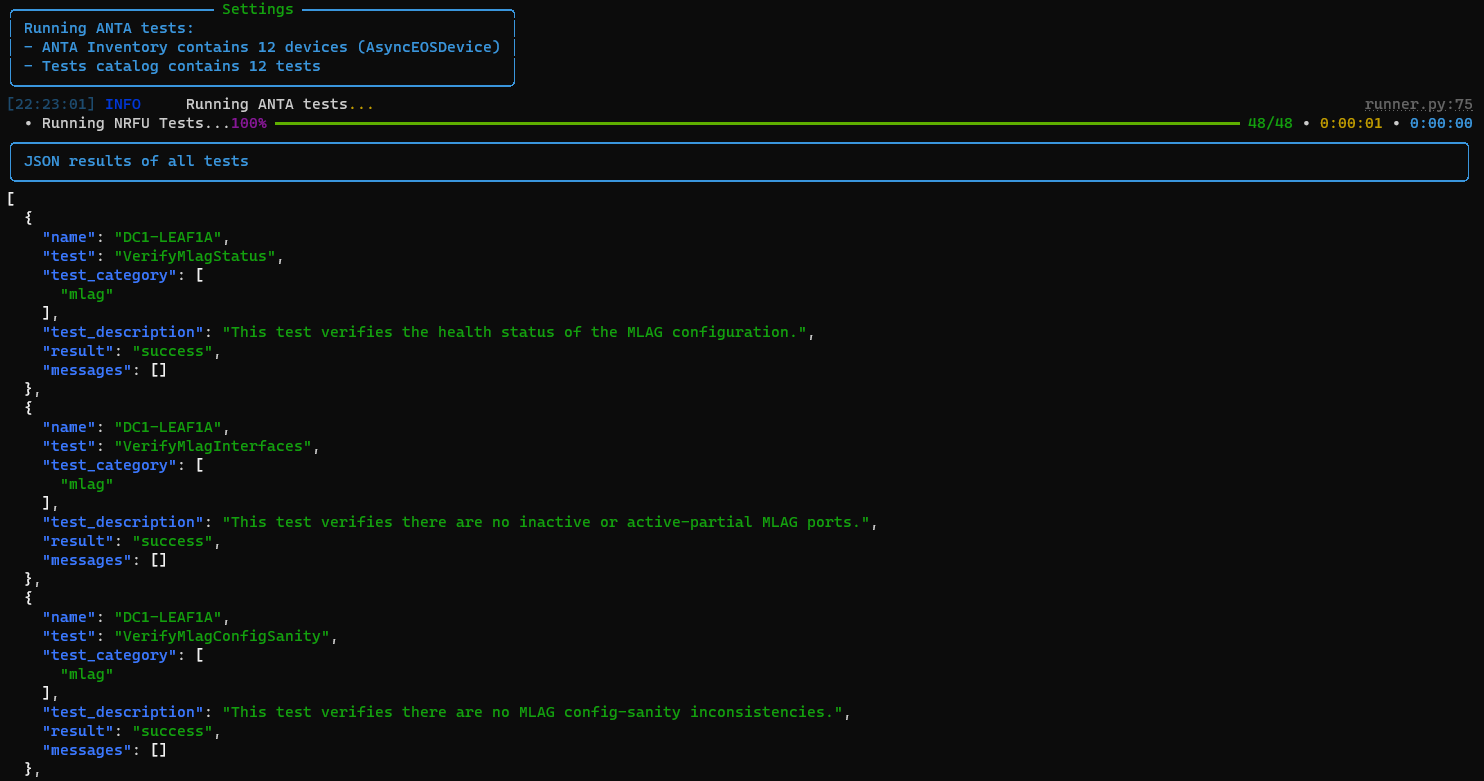7.3 KiB
Execute Network Readiness For Use (NRFU) Testing
ANTA provides a set of commands for performing NRFU tests on devices. These commands are under the anta nrfu namespace and offer multiple output format options:
NRFU Command overview
--8<-- "anta_nrfu_help.txt"
username,password,enable-password,enable,timeoutandinsecurevalues are the same for all devices
All commands under the anta nrfu namespace require a catalog yaml file specified with the --catalog option and a device inventory file specified with the --inventory option.
!!! info
Issuing the command anta nrfu will run anta nrfu table without any option.
Tag management
The --tags option can be used to target specific devices in your inventory and run only tests configured with this specific tags from your catalog. The default tag is set to all and is implicit. Expected behaviour is provided below:
| Command | Description |
|---|---|
none |
Run all tests on all devices according tag definition in your inventory and test catalog. And tests with no tag are executed on all devices |
--tags leaf |
Run all tests marked with leaf tag on all devices configured with leaf tag.All other tags are ignored |
--tags leaf,spine |
Run all tests marked with leaf tag on all devices configured with leaf tag.Run all tests marked with spine tag on all devices configured with spine tag.All other tags are ignored |
!!! info More examples available on this dedicated page.
Device and test filtering
Options --device and --test can be used to target one or multiple devices and/or tests to run in your environment. The options can be repeated. Example: anta nrfu --device leaf1a --device leaf1b --test VerifyUptime --test VerifyReloadCause.
Hide results
Option --hide can be used to hide test results in the output based on their status. The option can be repeated. Example: anta nrfu --hide error --hide skipped.
Performing NRFU with text rendering
The text subcommand provides a straightforward text report for each test executed on all devices in your inventory.
Command overview
Usage: anta nrfu text [OPTIONS]
ANTA command to check network states with text result.
Options:
--help Show this message and exit.
Example
anta nrfu --device DC1-LEAF1A text
Performing NRFU with table rendering
The table command under the anta nrfu namespace offers a clear and organized table view of the test results, suitable for filtering. It also has its own set of options for better control over the output.
Command overview
Usage: anta nrfu table [OPTIONS]
ANTA command to check network states with table result.
Options:
--group-by [device|test] Group result by test or device.
--help Show this message and exit.
The --group-by option show a summarized view of the test results per host or per test.
Examples
anta nrfu --tags LEAF table
For larger setups, you can also group the results by host or test to get a summarized view:
anta nrfu table --group-by device
anta nrfu table --group-by test
To get more specific information, it is possible to filter on a single device or a single test:
anta nrfu --device spine1 table
anta nrfu --test VerifyZeroTouch table
Performing NRFU with JSON rendering
The JSON rendering command in NRFU testing is useful in generating a JSON output that can subsequently be passed on to another tool for reporting purposes.
Command overview
anta nrfu json --help
Usage: anta nrfu json [OPTIONS]
ANTA command to check network state with JSON result.
Options:
-o, --output FILE Path to save report as a file [env var:
ANTA_NRFU_JSON_OUTPUT]
--help Show this message and exit.
The --output option allows you to save the JSON report as a file.
Example
anta nrfu --tags LEAF json
Performing NRFU with custom reports
ANTA offers a CLI option for creating custom reports. This leverages the Jinja2 template system, allowing you to tailor reports to your specific needs.
Command overview
anta nrfu tpl-report --help
Usage: anta nrfu tpl-report [OPTIONS]
ANTA command to check network state with templated report
Options:
-tpl, --template FILE Path to the template to use for the report [env var:
ANTA_NRFU_TPL_REPORT_TEMPLATE; required]
-o, --output FILE Path to save report as a file [env var:
ANTA_NRFU_TPL_REPORT_OUTPUT]
--help Show this message and exit.
The --template option is used to specify the Jinja2 template file for generating the custom report.
The --output option allows you to choose the path where the final report will be saved.
Example
anta nrfu --tags LEAF tpl-report --template ./custom_template.j2
The template ./custom_template.j2 is a simple Jinja2 template:
{% for d in data %}
* {{ d.test }} is [green]{{ d.result | upper}}[/green] for {{ d.name }}
{% endfor %}
The Jinja2 template has access to all TestResult elements and their values, as described in this documentation.
You can also save the report result to a file using the --output option:
anta nrfu --tags LEAF tpl-report --template ./custom_template.j2 --output nrfu-tpl-report.txt
The resulting output might look like this:
cat nrfu-tpl-report.txt
* VerifyMlagStatus is [green]SUCCESS[/green] for DC1-LEAF1A
* VerifyMlagInterfaces is [green]SUCCESS[/green] for DC1-LEAF1A
* VerifyMlagConfigSanity is [green]SUCCESS[/green] for DC1-LEAF1A
* VerifyMlagReloadDelay is [green]SUCCESS[/green] for DC1-LEAF1A
 { loading=lazy width="1600" }
{ loading=lazy width="1600" } { loading=lazy width="1600" }
{ loading=lazy width="1600" } { loading=lazy width="1600" }
{ loading=lazy width="1600" } { loading=lazy width="1600" }
{ loading=lazy width="1600" } { loading=lazy width="1600" }
{ loading=lazy width="1600" } { loading=lazy width="1600" }
{ loading=lazy width="1600" } { loading=lazy width="1600" }
{ loading=lazy width="1600" } { loading=lazy width="1600" }
{ loading=lazy width="1600" }